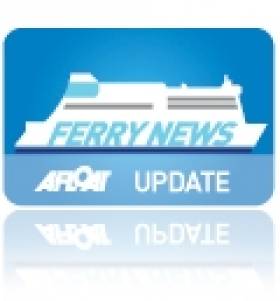Displaying items by tag: DouglasDublin
Sailings to Dublin by Isle of Man Steam Packet in 2024 will Not Involve New Flagship Manxman
The seasonal Douglas-Dublin ferry route operated by the Isle of Man Steam Packet is set to conduct 18 sailings to and from the Irish capital next year.
In the House of Keys earlier (last) week as IOM Today writes, the figures for the sailing timetable were revealed by Treasury Minister Dr Alex Allinson when answering questions relating to the Manx Government owned ferry-company.
Currently, the Steam Packet has no plans to deploy its flagship, the Manxman (serving Douglas-Heysham year round) to also run on the route to Ireland due to certain 'limitations'.
Dr Allinson said that while Dublin has 'never been a regular port' for the Steam Packet, the fast-ferry craft, Manannan will still conduct a number of crossings to the Irish port in 2024.
The Manannan, Afloat adds has been tracked today to Douglas where the final seasonal sailing on the route connecting Liverpool ended with the high-speed craft berthing in the Manx capital on 29 October.
Three days later, the former flagship Ben-My-Chree departed Douglas to arrive at H&W’s Belfast shipyard to the repair/outfitting quay. At the adjacent Belfast Dry-Dock is where Irish Ferries Dublin-Cherbourg cruise ferry W.B. Yeats is occupying for a routine annual overhaul.
Taking its place on the Ireland-France route is the Epsilon which mostly operates Irish Ferries Dublin-Holyhead route, however the ropax was replaced by the newly chartered Norbay from P&O, having entered service on the Ireland-Wales route yesterday (see report).
Manx-Dublin Weekends Seasonal Services
#ISLE OF MAN FERRY – On both weekends before and after Christmas, the Isle of Man Steam Packet Co. will be operating seasonal sailings on the Douglas-Dublin route.
A round-trip sailing will depart Douglas tomorrow (Saturday) at 19.30hrs with an arrival of the ro-pax ferry Ben-My-Chree in Dublin Port on (Sunday) just after midnight at 00.15hrs. The ferry will make her return departure to the Isle of Man, departing the Dublin Ferryport at 01.00hrs with an arrival at the Manx capital scheduled for 05.45hrs.
On the weekend after the festivities are over, the Isle of Man ferry is to repeat the round-trip, departing Douglas on Saturday 29 December (19.30) with arrival in Dublin Port on Sunday 30 December (00.15). The corresponding return sailing departs the Irish capital at 01.00hrs and docks in Douglas at 05.45hrs.
For sailing schedules including Manx-UK routes, click HERE.
Former US Navy Fast-Craft Re-opens Seasonal Dublin Route
Manannan's chequered career included a five year charter initially to the United States Navy but transferred to the United States Army Forces between 2001-2006. The 5,029grt craft (see photo) was used for various trials and demonstrations and in which saw service in the Persian Gulf in support of 'Operation Iraqi Freedom' and in 2003 'Operation Enduring Freedom' in the Horn of Africa.
An engine plant of 4 x Caterpillars diesel generates a speed of over 40 knots / 46 mph which provided logistical solutions by the High-Speed Vessel (HSV) to transport troops and supplies covering long distances in support of the Combined Joint Task Force.
Other tasks required by the force included the roles of operating as a mobile command centre which entailed working closely inshore and operating as a helicopter carrier. Helicopters landed at the craft's stern positioned helicopter landing deck.
The military role of the craft is in stark contrast compared to when the 96m ferry was launched in 1998 for civilian purposes as the Incat 050, the number representing the number of pioneering wave-piercing craft built by InCat in Hobart, Tasmania.
Asides her military days the 800-passenger / 200 vehicle fast-ferry has served the Hobart-Melbourne route, between New Zealand's north and south island and in European waters in the Mediterrean and to the Canary Islands.
Manannan (see photo) entered service last May after the Isle of Man Steam Packet Company (IOMSPco) purchased the vessel which was laid-up in Hobart. She made the long delivery to the northern hemisphere and was re-converted for ferry usesage during a refit in Portsmouth.
The 181 year-old company is the only sea-based passenger operator to the island on services linking Dublin, Belfast, Heysham, Liverpool and (Birkenhead) in the winter months.
There are rival companies such as the Ramsey Steamship Company but they are freight-only operators mostly running to Belfast and Liverpool using short-sea coastal traders and to other small Irish Sea ports.
An annual round island cruise is held and like last year the Manannan will be serving the cruise on Sunday 1 May departing Douglas at 11am for a journey of around 2 hours. The route closely circumnavigates the spectacular Manx coastline. For information on the island cruise and fares click here.






























































